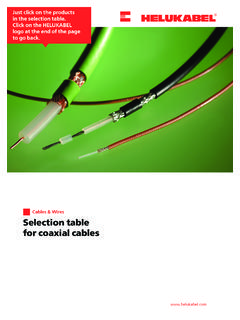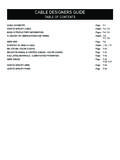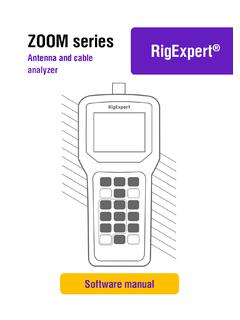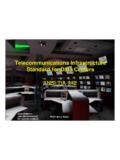Transcription of 4-Square Antenna in theory and practice - RemoteQTH.com
1 1 4-Square Antenna in theory and practice Observations and experiences of DF6QV June 2014 2 Preface A couple of years ago I became interested in 4-Square -antennas. It is an Antenna system which, as the name suggests, consists of 4 radiators, a coupler, phasing-lines, as well as a radial or ground system. The coupler is the core of the system. It distributes the output power to the radiators with proper amplitudes and phases. This article will firstly discuss the components of this Antenna system. Afterwards the influence of ground conditions and distance between the elements is shown. Different couplers will be analyzed using the simulation program LTSpice by Linear Technologies. The results, referring to the splitting of power, phasing and bandwidth are displayed in diagrams. Finally some photos hint at the practical construction of 4-Square . I d like to express my thanks to DJ2YA for his competent support. My further thanks go to the many Oms who have enabled me to gain these experiences.
2 3 Table of Contents: 1 Antennas, Arrays, 4-Squares Simulation of a 2-Element Array Azimuth-Plots Elevation-Plots Plots with 75 -135 Degree Phase Difference First Attempts of Array Antennas for Low Bands A Switchable Four-Element Phased Array 80m Simulation of the Array of W1 HKK from 1965 4-Square Array with Ground Plane Elements Principle of a 4-Square Antenna with Hybrid Coupler Radiator Arrangement Element Spacing in a 4-Square Antenna Ground Influence 2 Variants of 90-Degree-Couplers Simple 2-Element Array 3 dB Hybrid Coupler Implementation with Lines Implementation with Discrete Components The Reed Fisher Coupler The Coupler According to Reed Fisher Broadband Version The Coupler as a Phase Shifter Couplers in practice Strip-Line-Coupler Measurements on 80m Coupler for 5A7A 3 Power, Voltages, Currents and Losses in a 4-Square Antenna System Relays Capacitors Inductors Skin Effect Core Losses Radiator Radial System cable Losses Sum of Losses 4 Reed Fisher (W2 CHQ)
3 Coupler Design System Requirements Calculation Formulas Useful Dimensions 5 System Impedance, Bandwidth , SWR, Dumped Power System Impedance Bandwidth SWR Isolation - Power Splitting - Phase Difference Dumped Power 4 Current-Balun Mutual Coupling Power Matching Current-Forcing /4-Transformer 6 4-Squares in practice Radiators Common Mode Chokes Phasing Box 50 Ohm Dummy Load Remote Control Box Control Line Control Box Power Supply Power Test Phase Measurement of a MHz Coupler Complete System Set-up Notes Operation with 2 Radiators 4-Square Antennas for TS7N, 5A7A, VP6DX and TF7X Field Test with a 40m 4-Square 7 Literature and Web Links 5 1 Antennas, Arrays, 4-Squares A transmitting Antenna couples the power generated by the transmitter to the ether. The fields generated by the transmission of power in the Antenna elements overlap in the far field forming the radiation pattern of the Antenna .
4 In a receiving Antenna the electromagnetic fields generate the input power for the receiver. Often transmitting and receiving antennas are the same. The current, or rather the current segments in the Antenna produce fields. Their superposition results in the radiation pattern of the Antenna . EZNEC and MMANA are two Antenna modeling programs with a NEC2 core that use this principle. The gain of an Antenna is a measure of the energy concentration over the spacial angle. An isotropic Antenna is a theoretical reference Antenna that radiates uniformly into all directions. This cannot be achieved in the real world. Gains over isotropic antennas are specified as dBi. The half-wave dipole Antenna is often used as a further reference. Gains over the half-wave dipole are specified as dBd. The specification of antennas should always refer to these standard antennas in order to ensure the comparability of different models. Warning: In their prospectuses some companies include the additional gain of ground reflections to promote their antennas.
5 Nowadays antennas can be planned on the computer before you start building them. With the simulation of antennas you can let your scientific curiosity ramble freely. However, you should always consider whether it is possible to implement the model in the real world. It should be remembered that our amateur bands have a certain bandwidth. In IARU Region 1 the 80m band has a relative bandwidth of about 8 % and about 13% in IARU Region 2. Therefore you must ask the following questions. What bandwidth have the radiators? What bandwidth has the network for phase shift generation and power distribution? An Antenna array is characterized by the fact that each array element is fed directly. Array elements can be dipoles, Yagis, ground planes, just any Antenna you can think of. The directivity of an array is achieved by suitable phase and amplitude distribution in the individual array elements. Changes of phase and amplitude distribution in the elements will change the directivity of the Antenna system.
6 Thus it is possible to change beam direction without mechanical rotation of the Antenna itself. This is an advantage especially on the lower bands (160m, 80m and 40m), where rotatable directional antennas are very bulky and expensive. As the name implies a 4-Square is a square with an Antenna element at each corner. In the majority of cases they are verticals such as ground planes or vertical Simulation of a Two-Element Array The following example is a 2-element array. It consists of two /4-spaced /4-verticals. The two radiators are fed with equal amplitudes but different phases. The data for the simulation are shown in Figures to Array data for the simulation : Figure Figure Figure In the screenshots below, the lobes are shown at different phase assignments, the black curves represent the lobes at 0 degrees phase difference. The azimuth plots show an elevation angle of 25 degrees.
7 AZ30 is the plot for 30 degree phase difference, AZ60 for 60 degrees etc. This applies analogously for the elevation plots. The radiation patterns calculated with EZNEC are shown in Figures and for phase differences of 30, 60, 90, 120 and 180 degrees in the feed currents. Figs. and show the most interesting range of 75-135 degrees at intervals of 15 degrees. 7 Azimuth-Plots Figure Elevation-Plots Figure 8 Plots with 75 -135 Degrees Phase Difference The 2-element array has been simulated with an element spacing of /4 with the same amplitude and phase differences between 75 to 135 degrees. Figure The forward gain of the 2-element array is slightly less than 3 dB (see Figure ). An attractive front/back-ratio is achieved with an element spacing of /4 and a phase difference between 90 and 120 degrees. The gain of a /4 high dipole above average ground is about 7 dBi straight upward and dBi at 28 degrees elevation.
8 For successful DX traffic low elevation angle radiation is crucial. Interfering local signals from high elevation angles cover the DX-signal and are therefore undesirable. "Quantitative" gain figures do not count as much as the gain in "quality". This raises the question at which angle the Antenna radiates best and at which angles it has only small gain or even zeroes (cf. Figures and ). 9 Figure Figure First Attempts of Array Antennas for the Low Bands A Switchable Four-Element 80m Phased Array In QST, March 1965, pp. 48 - 52, W1 HKK describes an array in an article entitled "A Switchable Four-Element 80m Phased Array ". The required phase angles are generated by coaxial cables of appropriate length, impedance matching is done by /4-transformers. The principle is presented in Fig. Fig. shows the "harness" that is required for the proper phases and impedances in the array. The figures are taken from QST, March 1965.
9 10 Figure Figure 11 The array does not provide for switching the length of the cables for CW or SSB. If you cut the length of the /4-lines for the center of the band, the error is about 4 % and 7% at the band edges. Looking at the Smith chart the small error is acceptable. Simulation of the Array of W1 HKK from 1965 Figure Broadside Pattern, Figure End-Fire Pattern The simulation has been run with 5 radials close above the ground. The patterns depend on various parameters, such as the selection of the ground type, the version of the simulation software, etc. They illustrate only the principle of the array. 4-Square Array with Ground Plane Elements Since most 4-squares are built with ground planes, our focus is on the realization of different ground plane variants. There are several ways to make a radial system for ground plane antennas: In a ground radial system with a number of non-resonant radials in (or on) the ground the feed impedance depends on the number and length of the radials.
10 The more radials the lower earth losses. Above perfect ground the base impedance of a quarter wave radiator is close to 36 ohms. Ground planes can also have elevated radials that must be resonant. The higher above ground they are, the lower are ground losses. A good compromise is achieved if you keep them at a height of about one meter in a 40m system, two meters in an 12 80m system and four meters in a 160m system. If two or more identical radials are arranged symmetrically, their radiation is cancelled and only the radiation of the vertical radiator is effective. Radials form a capacity to ground. The higher radials are above ground, the smaller the capacity and thus the currents flowing back through lossy earth. Since the radiators of a 4-Square are spaced approximately /4, there may be interactions between the radials of the individual ground planes. To avoid that it is preferable to string just one radial diagonally outward.




